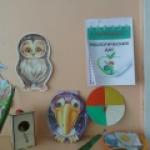Presentation of quilling: historical facts and types of craftsmanship. Lesson summary “History of the emergence of paper rolling technology - quilling History of quilling presentation
Slide 2
Quilling, also known as paper filigree or paper rolling, is the art of making flat or three-dimensional compositions from long and narrow strips of paper twisted into spirals. Although the origins of quilling are not recorded, some believe that the art form began immediately after the invention of paper in China in 105 AD. Kazakevich I.I. teacher of fine arts and drawing MBOU secondary school No. 93
Slide 3
It is believed that in the 300s and 400s, silver and gold stripes were used to decorate columns and vases, and using this technique to create beautiful Jewelry. By the 1200s this art form was very popular. Icon decorated with quilling Kazakevich I.I. teacher of fine arts and drawing MBOU secondary school No. 93
Slide 4
Quilling has been mentioned in written sources since the 1200s, but only gained recognition in the 1500s and 1600s. Back then, European nuns used quill pens to curl paper to frame scriptures, paintings, and book covers. Kazakevich I.I. teacher of fine arts and drawing MBOU secondary school No. 93
Slide 5
Nuns used quilling to imitate more expensive designs in wrought iron or carved ivory; and if they could not use gold and silver, they used paper and then plated the finished work with gold. http://stranamasterov.ru/ Kazakevich I.I. teacher of fine arts and drawing MBOU secondary school No. 93
Slide 6
At the end of the 16th century. Quilling became entertainment for noble ladies. It is historically described that quilling became more popular until the beginning of the 18th century. in Europe and England. Quilling was seen as a worthy hobby for young ladies (they were taught quilling along with embroidery). Schools of that time taught quilling as one of their courses. Design of the box Kazakevich I.I. teacher of fine arts and drawing MBOU secondary school No. 93
Slide 7
Only people with money could afford to buy quilling materials. Foil, mica or mother of pearl shells were often used as backgrounds. And only ladies from the upper strata of society had time for quilling, not needing work, but only filling their time while waiting for suitable suitors. Kazakevich I.I. teacher of fine arts and drawing MBOU secondary school No. 93
Slide 8
Quilling has never been a pastime for working class women. It flourished among ladies of the upper classes, where it was used to decorate screens, boxes, frames, teapots, cribbage boards, wine holders, baskets and boxes for storing sewing materials and accessories. Kazakevich I.I. teacher of fine arts and drawing MBOU secondary school No. 93
Slide 9
So, in the 15th century it was considered art. In the 19th century - ladies' entertainment. Most XX century it was forgotten. And only at the end of the last century quilling began to turn into an art again.
In England, Princess Elizabeth was seriously interested in the art of quilling, and many of her creations are kept in the Victoria and Albert Museum in London. Cabinet from the time of George III carving is quilling. Kazakevich I.I. teacher of fine arts and drawing MBOU secondary school No. 93
Slide 10
Portrait of the Marquise de Sade in a quilling frame Close-up frame Kazakevich I.I. teacher of fine arts and drawing MBOU secondary school No. 93
Description of the presentation by individual slides:
1 slide
Slide description:

1 slide
2 slide Quilling is the art of paper rolling, one of the types of decorative - applied arts
A little-known technique among us is the art of paper rolling or, as it is called, quilling.

1 slide
3 slide
The first widespread acquaintance of the people of Rus' with paper occurred in the middle of the 13th century, when Khan Batu, to collect tribute, carried out the first national census of the population of Rus' on paper. Before considering the history of quilling, let's remember the history of paper. After all, the main material used in quilling is paper.

1 slide
4 slide
In ancient Egypt, books were made from river reed papyrus. In a number of European countries, paper took its name from its predecessor, papyrus. Papyrus making originated in ancient Egypt around 3.5 thousand years BC.

1 slide
5 slide
The making of paper is usually associated with the name of the Chinese Cai Lun and dates back to 105 AD. The making of paper is usually associated with the name of the Chinese Cai Lun and dates back to 105 AD. However, paper began to be produced in China even earlier.

1 slide
6 slide In Russia they started making paper much later. There is information that paper own production
appeared in Russia in the mid-16th century under Ivan the Terrible. In Russia, paper began to be made much later. There is information that self-produced paper appeared in Russia in the mid-16th century under Ivan the Terrible.

1 slide
Quilling is based on the ability to twist long and narrow strips of paper into spirals and create three-dimensional or planar compositions from the resulting parts. Translated from English, quillin means “bird feather”, since previously strips of paper were wound onto the tip of a bird’s feather.) Quilling is based on the ability to twist long and narrow strips of paper into spirals, modify their shape and create volumetric or planar compositions from the resulting parts. Translated from English, quillin means “bird feather”, as strips of paper used to be wound around the tip of a bird’s feather.
8 slide

1 slide
This art originated in Europe at the end of the 14th century; in those days they used high-quality paper with gilded edges, so only rich ladies could practice this art. They made various decorations, paintings, and vases. This art originated in Europe at the end of the 14th century; in those days they used high-quality paper with gilded edges, so only rich ladies could practice this art. They made various decorations, paintings, and vases.
Slide 9

1 slide
French and Italian monks used the quilling technique to make small crafts, and then used them to decorate and frame icons. French and Italian monks used the quilling technique to make small crafts, and then used them to decorate and frame icons.
10 slide

1 slide
In the 18th century, filigree paper lace became popular throughout Europe. Girls were trained in special schools (and were considered one of the few things that were educational for ladies of that time). In the 18th century, filigree paper lace became popular throughout Europe. Girls were trained in special schools (and were considered one of the few things that were educational for ladies of that time).
11 slide

1 slide
Filigree became widespread exclusively among the upper strata of society. because paper was a very expensive material. Filigree became widespread only among the upper classes of society because paper was a very expensive material.
12 slide

On English language This needlework is called “quilling” - from the word “quill” or “bird feather”. Unlike origami, which originated in Japan, the art of paper rolling originated in Europe in the late 14th and early 15th centuries. IN medieval Europe nuns created elegant medallions by twisting paper with gilded edges onto the tip of a bird's feather. When viewed closely, these miniature paper masterpieces created the complete illusion that they were made of thin gold strips. Unfortunately, paper is a short-lived material and little has survived from medieval masterpieces. However, this ancient technique has survived to this day and is very popular in many countries around the world. Paper rolling quickly spread in Europe, but because paper, especially colored and high-quality paper, was a very expensive material, paper plastic art became an art for ladies from wealthy sections of society.
IN South Korea there is an entire Association of paper plastic art lovers, uniting followers of the most different directions paper creativity. In the 15th century it was considered art. At 19 - ladies' entertainment. For most of the 20th century it was forgotten. And only at the end of the last century quilling began to turn into an art again.
In England, Princess Elizabeth was seriously interested in the art of quilling, and many of her creations are kept in the Victoria and Albert Museum in London. We associate paper with the idea of fragility and fragility. But quilling refutes this statement - you can put, for example, a cup or a heavy book on a filigree volumetric stand, and not a single curl of paper lace will be harmed. You can assemble a candy vase from paper elements and safely use it for its intended purpose - it will not fall apart or break. In general, quilling is an opportunity to see the unusual possibilities of ordinary paper.
View document contents
"Presentation "Quilling: history, materials, tools and devices. Technique."
Branch of GBOU SPO RO "DPK" in the city of Azov.
QUILLING: HISTORY, MATERIALS, TOOLS AND DEVICES. TECHNIQUE OF EXECUTION.
Performed by a student of group P-3
Specialty 050148
"Pedagogy of additional education"
Chernik Anastasia.
History of technology.
In English, this needlework is called “quilling” - from the word “quill” or “bird feather”. Unlike origami, which originated in Japan, the art of paper rolling originated in Europe in the late 14th and early 15th centuries. In medieval Europe, nuns created elegant medallions by twisting paper with gilded edges onto the tip of a bird's feather. When viewed closely, these miniature paper masterpieces created the complete illusion that they were made of thin gold strips. Unfortunately, paper is a short-lived material and little has survived from medieval masterpieces. However, this ancient technique has survived to this day and is very popular in many countries around the world. Paper rolling quickly spread in Europe, but because paper, especially colored and high-quality paper, was a very expensive material, paper plastic art became an art for ladies from wealthy sections of society.
Nowadays, paper rolling is widely known and popular as a hobby in countries Western Europe, especially in England and Germany. But this art became most widespread when it “moved” to the East. The richest traditions of the finest graphics and plastic arts, papermaking and working with it have given the art of paper sculpture a new life.
In South Korea, there is an entire Association of Paper Art Lovers, uniting followers of various areas of paper art. In the 15th century it was considered art. At 19 - ladies' entertainment. For most of the 20th century it was forgotten. And only at the end of the last century quilling began to turn into an art again.
In England, Princess Elizabeth was seriously interested in the art of quilling, and many of her creations are kept in the Victoria and Albert Museum in London. We associate paper with the idea of fragility and fragility. But quilling refutes this statement - you can put, for example, a cup or a heavy book on a filigree volumetric stand, and not a single curl of paper lace will be harmed. You can assemble a candy vase from paper elements and safely use it for its intended purpose - it will not fall apart or break. In general, quilling is an opportunity to see the unusual possibilities of ordinary paper.
It should be noted that the Korean school of quilling (they call it paper rolling) is somewhat different from the European one. European works, as a rule, consist of a small number of parts; they are laconic, reminiscent of mosaics, and decorate postcards and frames. Europe is always in a hurry, so it loves fast technology. Eastern masters create works that resemble masterpieces of jewelry. The finest voluminous lace is woven from hundreds of small details. Masters of the Eastern school prefer to perform twisting using a thin awl. A replacement can be made from a thick needle and cork.


Weaving technique
1.Take the strip with two fingers.
2. Pull the end of the strip with pressure with two fingers of your other hand, running your nail along it so that the end bends slightly. This is necessary to make the tip easier to wrap around an awl or toothpick.
3.Tightly wrap several turns of paper around the awl.
4.When the diameter of the roller becomes 3-4 mm, it can already be removed from the awl and further turned by hand.
5.Twist the thick disk with both hands, always intercepting it with your fingers so that the paper tape does not unravel.
6.Fold the entire strip of paper.
7.When the paper is all folded, relax your finger and let the paper spiral unravel a little.
8.Glue the end of the strip with a PVA strip.
9. If you squeeze the workpiece with two fingers, you will get a “drop” workpiece.
Workpieces can be given a variety of shapes by performing compressions and indentations. There are 20 in total basic elements, but the principle remains the same: roll and pinch.

Quilling technique
Examples of blanks
- Original roll Basic form

Drop Leaf Square
Triangle
Hare's ear
twisted heart














Quilling is a fairly popular modern hobby, the main essence of which comes down to creating compositions and figures from twisted strips of paper. This is an English word (in English “quilling”), which comes from the word “quill” - “bird feather”.
Where did this art come from? What are the types and methods of paper rolling? Why is quilling attractive and useful for children and adults?
Before starting to study quilling, the presentation will introduce you to the varieties of this art and give you the opportunity to learn Interesting Facts, as well as the beneficial and developmental properties of quilling.





It may surprise many, but the history of quilling dates back to the end of the 14th century. It was then that European monks began to decorate books, icons and medallions with rolled paper.
At that time, quilling was known as paper filigree and paper mosaic. Openwork patterns, flowers and ornaments were rolled out of thin strips of paper and bird feathers were used for this. It is from this tool that the name of the quilling technique comes.
To make the craft beautiful and luxurious, trimmed gilded edges of book pages were used. The result was spirals that imitated gold jewelry (hence the comparison with filigree, a jewelry technique for decorating metal).
According to another version, the art of paper folding came to Europe from the New World. For twisting, a porcupine quill was used, which in English is also called “quill”.
However, for quilling, the history of origin begins in ancient times and leads to the ancient Chinese civilization and Ancient Egypt, when paper and papyrus were first invented. It is not known for certain who exactly – the Chinese or the Egyptians – came up with the idea of rolling paper. But, of course, this type of art migrated from East to West and from West back to the East.
Thus, in the 19th century, quilling flourished as a hobby for ladies from high society, and at the end of the 20th century it firmly took its position in South Korea. Koreans, with their characteristic oriental patience and accuracy, began to create truly works of art that are not inferior to jewelry, and even created schools for teaching the art of quilling.

In the XVIII-XIX centuries. paper, especially high-quality and durable paper, was quite expensive, so this hobby was accessible only to nobles and royalty. For durability and aesthetic appearance, the finished craft was coated with gold or silver.
It is worth noting that the art of paper rolling was the favorite pastime of the English Princess Elizabeth. Largely thanks to her, quilling gained its popularity. Many of the princess's works are preserved in the Victoria and Albert Museum in London.
Quilling was forgotten for almost the entire 20th century, but in the 21st century it regained its popularity. The availability of materials and tools, as well as the ease of making beautiful things, have made this type of creativity an everyday hobby for many needlewomen and craftsmen.
Video: History of technology
What is quilling?
At first glance, the quilling technique is quite simple. Indeed, the basic principle is to twist strips of paper of equal width into tight or loose spirals, from which a painting or craft will later be assembled. However, quilling has its secrets and features.
 Conventionally, all types of quilling techniques can be divided into two large groups– European school and Korean school.
Conventionally, all types of quilling techniques can be divided into two large groups– European school and Korean school.
European style is laconic. When creating quilling crafts in this style, a small number of parts are used that are assembled together like a mosaic. Compositions can be assembled from tight, dense spirals or basic quilling figures, which are formed from loose spirals. This style is most often used to decorate cards, frames, album covers and notebooks. Korean or Asian style is more subtle and elaborate. Koreans have developed the art of quilling to perfection. Works made in this style are difficult to distinguish from real filigree. Craftsmen work out every detail, use many elements and try to create monolithic works without any signs of paper seams or edges. The Korean school creates entire paintings made from strips of paper.
However, each school uses well-known techniques in its work, among which are:
- spiral quilling;
- bihive;
- contour quilling or hasking.
Compositions made from spirals are the simplest quilling technique that all beginners are familiar with. This technique is actively used by the European school. Using a special awl or other improvised device (sticks, toothpicks), spirals are rolled up and basic shapes are created, which are folded according to the intended pattern into a single composition. The larger and smaller the figures, the neater the work looks. Even children can easily master this technique.
Beehive literally means “honeycomb” or “beehive.” This technique creates details filled with spirals and curls that actually somewhat resemble a honeycomb. Most often, this technique is used to create petals, leaves, tree crowns and filled extensive geometric shapes. The details are delicate, delicate and neat.
Contour or graphic quilling or husking is somewhat more complicated and requires some skills, as well as artistic vision, perseverance and patience. Using this technique, one gets the impression of a picture drawn with pencils or strokes. The parts are filled with slightly curved, wavy or arched strips, which are glued to the paper edgewise.
For beginners, understanding and mastering this technique will be quite difficult at first. However, having acquired some skill, masters will be able to create full-fledged paintings, even without knowing how to draw. For contour quilling, templates and sketches with drawing small lines are used.
Also, types of quilling can vary in volume (flat or three-dimensional crafts) and theme (geometric, naturalistic, fantasy, portrait, etc.). Using quilling, you can create topiaries, decorative compositions (panels, postcards, paintings), figures and toys, household items (vases, boxes, baskets).
The art of quilling, as you can see, goes far beyond simple paper spirals.
Video: Basic elements of quilling
Why do quilling?
Quilling can not only please the eye, but also help in development, especially for children. This is a great way to develop fine motor skills, which are inextricably linked with brain activity. Assembling crafts from thin and tiny parts contributes to the development of intelligence, attention, speech and thinking centers.
A child who engages in paper rolling will easily learn the necessary self-care skills, be able to logically construct sentences and draw cause-and-effect relationships. As a rule, parents of children pay attention to fine motor skills preschool age: Well-developed hand motor skills indicate sufficient preparation for school.
In addition to developing thinking and memory, the art of paper rolling develops creative and artistic abilities, and cultivates an aesthetic perception of reality.
Both boys and girls can do quilling. The main thing is to select topics and techniques that will be interesting and understandable to children. For preschoolers, these can be simple compositions from basic figures, for older children - three-dimensional sculptures and semi-volumetric panels. For complex and large-scale work, it is recommended to organize joint work. This is how children learn to work in a team.
Next entry Getting to know the technique of contour quilling
The development of fine motor skills of the hands is one of the current problems. This problem can be solved by modeling paper strips - quilling. This is a simple type of needlework that does not require large expenditures and is accessible to everyone. You can get your children interested in this, and I assure you that they will really like this activity.
Goal of the work:
Comprehensive intellectual and aesthetic development of children in the process of mastering the elementary techniques of quilling technique, as an artistic method of designing from paper.
Download:
Preview:
To use presentation previews, create a Google account and log in to it: https://accounts.google.com
Slide captions:
Municipal Autonomous Preschool Educational institution TsRR d/s No. 5 “Chamomile” Quilling.
History of quilling. The art of paper rolling originated in Europe in the late 14th and early 15th centuries. In medieval Europe, nuns created elegant medallions by twisting paper with gilded edges onto the tip of a bird's feather. When viewed closely, these miniature paper masterpieces created the complete illusion that they were made of thin gold strips. Unfortunately, paper is a short-lived material, and little has survived from medieval masterpieces. However, this ancient technique has survived to this day and is very popular in many countries around the world. Paper rolling quickly spread in Europe, but because paper, especially colored and high-quality paper, was a very expensive material, paper plastic art became an art for ladies from the upper classes. Quilling courses were held in the most elite schools.
Relevance of the problem. The development of fine motor skills of the hands is one of the current problems. This problem can be solved by modeling paper strips - quilling. This is a simple type of needlework that does not require large expenditures and is accessible to everyone. Having become acquainted with the simplest elements of quilling at our master class, you will be able to captivate your children with this, and I assure you that they will really like this activity.
The advantages of quilling as a direction of decorative and applied art: easy-to-learn techniques for working in this technique, developing fine motor skills; greater opportunity for students to express themselves and demonstrate creativity; products using the quilling technique are highly artistic and harmoniously combined in modern interior; easily made devices for performing elements using the quilling technique (based on a toothpick or plastic tube); relatively cheap and accessible materials (colored office paper and PVA glue).
Purpose of the work: comprehensive intellectual and aesthetic development of children in the process of mastering the elementary techniques of quilling technique, as an artistic method of designing from paper.
Materials and accessories for work: -D two-sided colored paper-Device for twisting paper tapes. This can be a wooden stick 10 cm long and a tapestry needle with a large eye. Insert the tip of the needle into the end of the stick and “bite off” the tip of the eye with pliers so that a gap remains. -PVA glue -Toothpicks (used to apply glue to the workpiece). -Scissors -Tweezers -Cardboard (to create the main background of the picture). -Ruler with round holes of various diameters (officer's). -A board or mat on which to cut, -Any suitable paper with a beautiful texture - for the base. -Metal ruler. -Stationery knife.
Paper The paper must be colored on both sides. You can buy cut paper at a specialty store or cut it yourself. The width of the strips should not usually exceed 3-7 mm. Standard strips are considered to be 27 cm long and 3 mm wide. If it is not possible to purchase specialized paper, then it can be replaced with white printer paper (not too thin) or colored origami paper. White makes excellent workpieces for snowflakes and other winter patterns. The color should be selected according to density and see if it is completely painted, i.e. is there a white stripe on the cut? You can cut with scissors along the markings or with a stationery knife along a metal ruler.
Basic forms: spiral - wind a narrow strip of paper on a knitting needle, remove it by taking both ends, spread it apart - you get a spiral; tight spiral - twist the ribbon and glue the tip without removing the spiral from the needle so that the ribbon does not unwind; free spiral - twist the ribbon, remove the spiral from the needle and, before gluing the end, let it unwind; drop - make a loose spiral and squeeze it on one side so that it takes the shape of a drop; curved drop - make a drop and bend its corner; eye - make a free spiral and squeeze the opposite sides, giving it the shape of an eye: leaf - make a free spiral and squeeze it in the shape of an eye and bend the corners in different directions; rhombus - make an eye and squeeze both corners to give the workpiece a diamond shape; triangle - make a loose spiral and compress it in three places to form a triangle. Using these techniques, you can create extraordinary compositions: from a simple flower to the most sophisticated projects.
Basic forms
Weaving technique Take the strip with two fingers. Pull the end of the strip with pressure with two fingers of your other hand, running your nail along it so that the end bends slightly. This is necessary to make the tip easier to wrap around an awl or toothpick. Twist several turns of paper tightly around the awl. When the diameter of the roller becomes 3-4 mm, it can already be removed from the awl and further turned by hand. Twist the thick disk with both hands, always intercepting it with your fingers so that the paper tape does not unravel. Roll up the entire strip of paper. When the paper is all folded, relax your fingers and let the paper spiral unravel a little. Glue the end of the strip with a PVA strip. If you squeeze the workpiece with two fingers, you will get a “drop” workpiece. Workpieces can be given a variety of shapes by performing compressions and indentations. There are 20 basic elements in total, but the principle remains the same: roll and pinch.
My works
Thank you for your attention!






